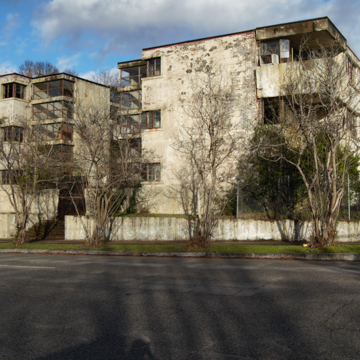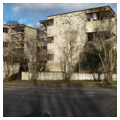Despite Birmingham’s Art Deco skyscrapers of the 1920s, modernism came late to Alabama domestic architecture. To European eyes, the Grove Court Apartments might call to mind blocks of flats erected after World War I in places like Dessau and Berlin or London and Paris, but the style was brand new to most Montgomerians just emerging from World War II. A 1947 article in the local newspaper assured its readers that the 70-unit apartment complex “will introduce revolutionary ideas in architecture and design into Montgomery.” In terms of residential architecture, Grove Court and the more muted LaGarde Apartments in Anniston built about the same time, were probably the first large-scale projects in the state to express, unalloyed, the concepts and ideas embodied in what had by then come to be known as the International Style.
The Montgomery apartment complex was the brainchild of local businessman Carl W. Bear. Seeing an opportunity in the postwar housing shortage, Bear acquired property on the then prestigious South Court Street and, together with brothers Joe and Jack, incorporated the new venture in 1946 as the Grove Court Apartments, Inc. The name was coined from the location of the new complex at the corner of Grove and Court streets. With a generous government-insured loan available through the Federal Housing Agency (FHA), the Bear brothers secured the services of local architects Clyde C. Pearson, Farrow L. Tittle, and Parker A. Narrows to design the Grove Court. Also briefly associated with the project was a fourth architect, John H. Hancock. The resulting scheme, commended “for its clarity of plan and adaptation to site and climate,” earned an honorable mention in the Progressive Architecture Awards for 1947, and further notice in the June 1948 and February 1949 issues of the magazine.
The footprint of the Grove Court complex consists of two outer, three-story blocks running back from Court Street—each block contained eighteen apartment units. The two outer blocks flank a U-shaped inner block of apartment units fronting onto a broad, street-facing courtyard. At the rear of the courtyard, the block forming the bottom of the “U” is raised on pilotis, or piers, in order to provide a covered area underneath connecting to what was originally an alley parking area enclosed by a low wall.
Horizontal bands of metal casements and heavy, apron-walled corner balconies of reinforced concrete define the two outer street elevations of the Grove Court. But inside this protective perimeter, all apartments open directly onto balcony-like covered walkways interconnected at all three levels via bridges and glassed-in stair towers. Surprising in subtropical Montgomery, apartment ceilings are only eight feet high in a complex built without central air conditioning. A mixture of one- and two-bedroom apartments—each with a living/dining area, kitchen, and bath—were targeted especially toward professionals working only a few blocks away in downtown Montgomery, and war veterans wanting, as the Montgomery Advertiser said, “to rent good class homes.” Other amenities included community laundry and drying facilities on the roof, lockers in the basement, garbage chutes to the general garbage center, a special play area for children, and all electric kitchens in the apartments.
For half a century, Grove Court continued to function as an apartment complex even as the professional middle class to which it once catered increasingly opted for other parts of the city. Derelict since the 1990s, the apartment complex was listed on the National Register of Historic Places in 2013. Today, though abandoned and neglected, it still remains the premier example of the International Style in Montgomery.
References
Benton, Jeffrey C. A Sense of Place: Montgomery’s Architectural Heritage, 1821-1951. Montgomery, AL: River City Publishing, 2001.
“Court Street Named as Site of Apartment.” Montgomery Advertiser(Alabama), January 18, 1947.
Schneider, David B., “Grove Court Apartments,” Montgomery County, Alabama. National Register of Historic Places Registration Form, 2013. National Park Service, U.S. Department of the Interior, Washington, D.C.

















